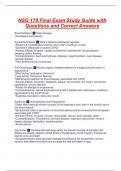NSG 170 Final Exam Study Guide with
Questions and Correct Answers
Bronchodilators ✅*Open Airways
*Decrease bronchospasm
Sympathomimetics ✅*Beta 2 selective adrenergic agonists
*Albuterol & Levelalbuteral used for short relief; 2 puffs prn or QID
*Salmeterol (Moderate to severe COPD)
*Adverse Effects: GI upset, cardiac arrhythmias, hypertension, bronchospasm,
sweating, pallor, flushing
*Contraindications: heart dysrhythmias, diabetes, hyperthyroidism, heart disease,
vascular disease
*Take 30-60mins prior to exercise
Anti-Cholinergcs ✅*Blocks vagally mediated reflexes by antagonizing the action of
acetycholine
*Short Acting: Ipratropium (Atrovent)
*Long Acting: Tiotroprium (Spiriva)
*Maintenance treatment of bronchospasm associated with COPD
*Adverse Effects: Dizziness, headache, fatigue, nervousness, dry mouth, sore throat,
palpitations, urinary retention
*Assess for allergies to soy/peanuts
*Contraindications: narrow angle glaucoma, BPH, bladder/neck obstruction, conditions
aggravated by dry mouth/throat
*Sugarless lozenges to relieve dry mouth
Xanthines ✅*Aminophylline and Theophylline
*Direct effect relaxing smooth muscles of the respiratory tract, both in the bronchi and in
the blood vessels
*Symptomatic relief or prevention of bronchial asthma and for reversal of bronchospasm
associated with COPD
*Adverse Effects: GI upset, nausea, tachycardia, seizure, brain damage, death
*Contraindications: GI problems, coronary disease, respiratory dysfunction, renal or
hepatic disease, alcoholism, hyperthyroidism
*Avoid caffeine
Key Points ✅*Xanthine-derived drugs affect the smooth muscles of the resp tract.
Effects are directly related to blood levels of theophylline (10-20 mcg/dL). Excess can
lead to coma and death
*Sympathomimetic (beta agonists) replicate the effects of the sympathetic nervous
system; they dilate the bronchi and increase the rate and depth of resp
,*Anticholinergics affect the vagus nerve to relax bronchial smooth muscle and promote
bronchodilation.
Corticosteriods ✅*Prednisone (end in "one" or "sone")
*Act by altering the inflammatory process that leads to swelling and further narrowing.
*May be given inhalation or systemic (oral or IV)
*Long term complications of oral include hyperglycemia, increased risk of infection,
swelling/wt gain, and osteoporosis
*Inhaled can be given alone or in combination with a LABA
*Must taper! Esp when switching to inhaled steroid! Adrenal insufficiency.
*If taking a quick acting bronchodilator like Albuterol, should take it prior to the inhaled
steroid
Inhaled Steroid ✅*Fluticasone (Flovent); Budesonide DPI (Pulmicort Flexhaler)
*Decrease the inflammatory response in the airway
*Prevention and treatment of asthma
*Treat chronic steroid-dependent bronchial asthma
*Adverse Effects: Sore throat, hoarseness, coughing, dry mouth, Pharyngeal and
laryngeal fungal infections
Fixed Combination Respiratory Drugs ✅*LABA/Corticosteriod: Fluticasone/salmeterol
(Advair, Advair Discus), Budesonide/formoterol (Symbicort)
*SABA/Anti-cholinergic: Ipratropium/albuterol (Combivent)
Leukotriene Receptor Antagonists ✅*Zafirlukast (Accolate); Montelukast (Singulair)
*Selectively and competitively block or antagonize receptors for the production of
leukotrienes which similar to histamine play a role in "allergic" inflammatory disorders
(i.e. hay fever, asthma)
*Prophylaxis and chronic treatment of bronchial asthma
*Adverse Effects: Headache, dizziness, myalgia, nausea, diarrhea and abdominal pain,
elevated liver enzyme concentrations, vomiting, and generalized pain
*Hepatic or renal impairment (effects metabolism and excretion
*NOT FOR ACUTE ATTACKS!
Mast Cell Stabilizers ✅*Cromolyn (Nasalcrom)
*Works at the cellular level to inhibit the release of histamine and inhibits the release of
SRSA
*Treatment of chronic bronchial asthma, exercise induced asthma, and allergic rhinitis
*Few adverse effects
*NOT USED FOR ACUTE ATTACKS!
Key Points ✅*Corticosteroids decrease the inflammatory response. The inhalable form
is associated with fewer systemic effects than other routes
*To block various signs and symptoms of asthma, the leukotriene receptor antagonists
block or antagonize the receptors for the productions of leukotrienes (responsible for
allergic type inflammation similar to histamine)
, *The mast cell stabilizer cromolyn blocks the release of histamine and other chemicals
associated with an allergic reaction. This decreases the inflammatory reactions.
Pulmonary Function Test ✅*Uses spirometer hooked to measuring device (resp tech)
*Determines lung volume, ventilation, and gas exchange
*Wide range of normals: Ht, Wt, Age, Gender
*No smoking 4-6 hours prior
*No bronchodilators or opioids 6 hours prior
Peak Flow Meter ✅*Peak Expiratory Flow Rate: At home by patient's to monitor.
Based on patient's personal best.
Arterial Blood Gases ✅*Measurement of arterial oxygenation and carbon dioxide
levels as well as acid-base balance.
*Note the patient's body temperature and any O2 or mechanical ventilation used (Pre-
Procedure)
*Allen's Test (Pre-Procedure)
COPD ✅*"A preventable and treatable disease with significant extra-pulmonary effects
that may contribute to the severity in individual patients. Its pulmonary component is
characterized by airflow limitation that is not fully reversible. The airflow limitation is
progressive and associated with an abnormal inflammatory response of the lung to
noxious particles or gases"
*Defined by GOLD (Global initiative for chronic Obstructive Lung Disease)
*A Leading cause of death and disability.
*COPD includes diseases that cause airflow obstruction (emphysema, chronic
bronchitis)
*Periods of acute exacerbation
*Destruction of the walls of the alveoli.
Reduction of the pulmonary capillary bed increases pulmonary vascular resistance and
pulmonary artery pressures.
*Increased pulmonary artery pressure may cause right-sided heart failure (cor
pulmonale) evidenced by edema, JVD, and hepatomegaly.
*Air trapping and characteristic barrel chest appearance.
*Decreased ability to "expire" CO2 leads to hypercapnea and respiratory acidosis and
ultimately resp failure
*Hypoxemia may lead to polycythemia.
*30-50% of smokers develop COPD
*Tends to lean forwards and use accessory muscles to breathe
Diagnostics for COPD ✅*PFT
*ABG
*Chest X-ray
*Alpha1 Anti-tripsyn in those <45 and strong family hx
Goals for COPD ✅*Stabilize, manage disease progression




